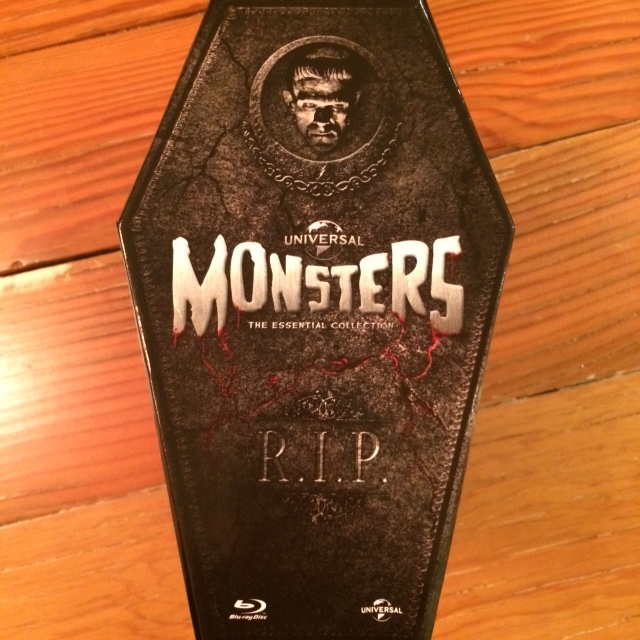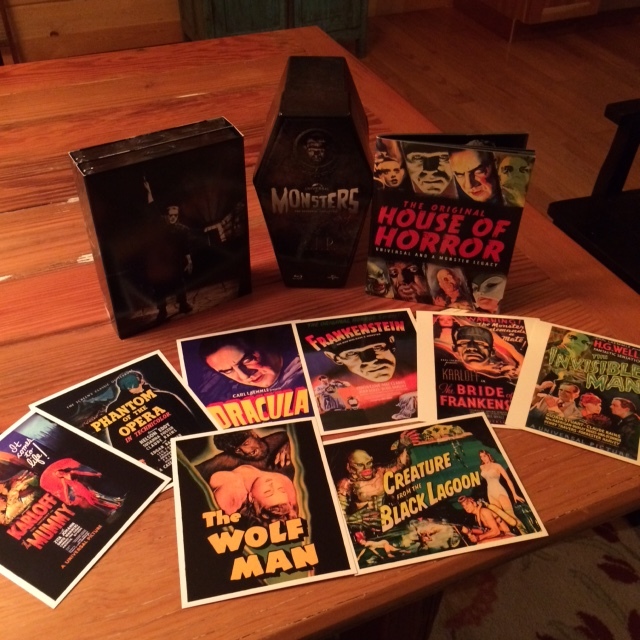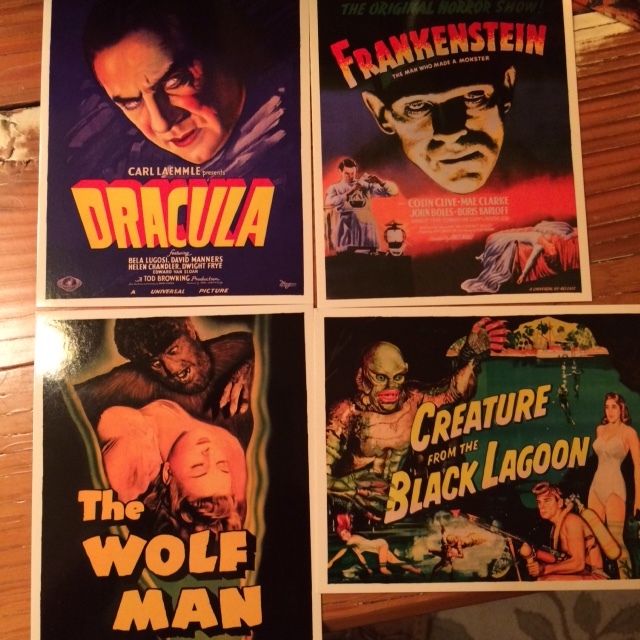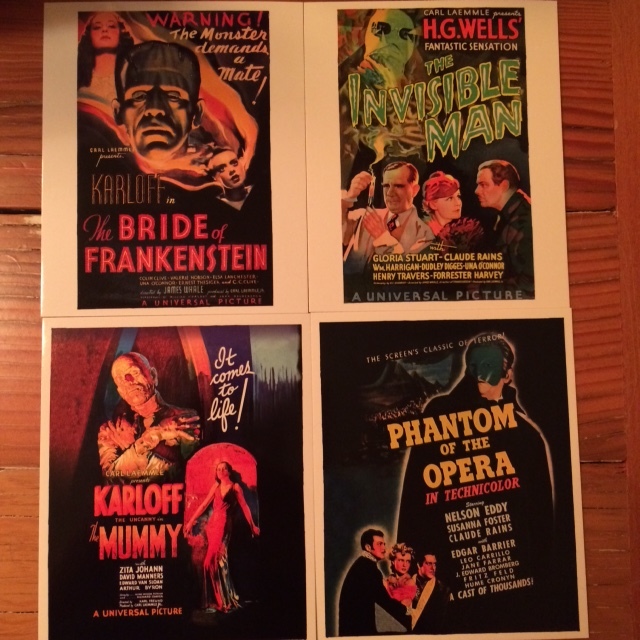Universal Monsters
My first exposure to the classic Universal Monsters came in the form of a card game.
Yes, in 1964 Milton Bradley released a monster version of Old Maid! I found this card game at my grandparents' house when I was a little kid in the mid-1970s. The game must have belonged to one of my aunts. I'd look at these cards and get scared and a few were creepy. I mean, they were mostly the disembodied heads of monsters, and when you're four or five years old it's scary! I sometimes wonder what happened to those cards.
My next exposure to the Universal Monsters was through watching Abbott & Costello at my grandparents' house on Sundays after church. To this day I enjoy Abbott and Costello Meet Frankenstein and that was my first real exposure to the film monsters. Watching Abbott and Costello was a good way of being introduced to these guys. It's a fun film, try it some time, it has Bela Lugosi and Lon Chaney Jr., and Vincent Price does the voice of the Invisible Man at the end of the film. It's funny, and as a kid it was both funny and scary.
A few years ago, Universal released a few sets of the famous Universal Monsters, some came in a plain old case, but I found the Coffin Collection and knew that was the set I needed!
The set contains the classic films: Dracula (and a second, Spanish version of Dracula that was shot on the same sets, but only when the main production wasn't filming, and to be honest, it's really good!). Frankenstein, The Mummy, The Invisible Man, The Bride of Frankenstein, The Wolfman, The Phantom of the Opera, and The Creature From the Black Lagoon(includes the original 3D version on Bluray!).
The coffin case contains a few goodies, like a booklet, and eight poster cards, one for each of the main films. I love this set, and while the films aren't as truly frightening as some that have followed, they're fun and even some of the special effects are still pretty cool!
Until Dawn - Interactive Horror for PS4
You know, I don't often write about video games, but now I'm writing about Until Dawn for the PS4. This game is an interactive horror film where you, the player, gets to make all those moronic decisions you yell at the screen about while watching a horror film. And there is a really fine implementation of the "butterfly effect" in the game...
You know, I don't often write about video games. In fact, I don't think I've ever posted about one on my website, until now, and I'm writing about Until Dawn from Supermassive Games. I hate to write this, but for those with other platforms, it's a PlayStation 4 exclusive that was released back in August of 2015.
When I began writing fiction seriously again around a decade or so ago, the time I allotted for gaming (video, RPG, tabletop, board, etc.) dwindled to nearly zero. Every once in awhile I'll find a title that intrigues me, and this time it was Until Dawn that hooked me.
The game is an interactive horror film, and while it's filled with some pretty standard tropes, the description of the gameplay interested me enough to give it a whirl.
Okay, here is the setup and the tropes you'll recognize right off: the game involves a group of teenagers who are probably 18 or 19 given the clues you'll find in game. These teens get together in a remote cabin up in the mountains one year after the disappearance of two of their friends who are twin sisters of one of the teens. Of course, they are then terrorized by a psychopath who toys with them and they must survive until dawn.
Okay, that doesn't sound all that original, and it isn't. But that is the briefest of explanations regarding the plot that I'll give--I'd hate to spoil the game (even though it's been out for a awhile now). What makes this game interesting is the gameplay and implementation. This is the first game in a long time that made me come back to it and made me think about it after I'd stopped playing.
First off, you get to play all of the characters, each of them will take center stage throughout the story and you'll find clues, make critical decisions that will not only affect that character, but the other characters. In the game this is called the "butterfly effect" and some choice made early in the game may have a sever impact later on. There are a couple of cool things about this butterfly effect and the way it's implemented. They use Native American lore to explain the significance, and throughout the game there are also totems that characters will find that foreshadow events (such as a characters death, saving someone's life, that sort of thing), so these can help when making decisions and impact the butterfly effect. The other great thing is that these decisions have their own screen and the player can flip through them and see how these events impacted the story and characters as you play.
As this is happening, a story unfolds, and there are times characters have to make a choice on the fly, such as investigate a noise or follow footprints, or stay with the group or investigate noise on your own. These are things you'd be yelling at the screen for if this were a movie, and you'll find yourself making decisions that are the lesser of two evils (until you find out later on it wasn't the lesser of two evils!). And then there are chase scenes where the screen will flash an icon and you need to hit the corresponding button on your controller, but these aren't often, but it's extremely stressful when it happens and I could feel the adrenaline kick in.
Given the choices all these characters can make, this leads to probably hundreds of different scenarios, and the choices the player makes will affect which characters make it until dawn. My first go through, I had 3 out of the 8 survive. Going into the last few minutes until dawn I actually I had 5, but then lost 2 from a decision I had to make in a matter of seconds.
This game lends itself to multiple play-throughs. The good thing is that once you've completed the game once you can access the chapters (the game is divided into chapters), which are also cleverly done and end in cliffhangers, and after a brief interlude (with a psychiatrist who explores your fears--and then those fears get implemented into the game), there is a recap of what happened before in the form of: Previously on Until Dawn, which then gives the highlights.
The effects of all these decisions even plays into how the characters then react to one another and they'll stop trusting each other or perhaps grow closer. I found myself really bummed when a couple of my favorite characters bit it. Another thing, sometimes you are given a choice, and it may seem you have to do something, but there are times when it's good to not hit the button to do something.
A few of the cast members are fairly well known, such as Hayden Panettiere (Heroes) and Rami Malek (Mr. Robot). The in-game characters are not only voiced by them, but modeled on them. The photos of Hayden Panettiere and Rami Malek are from the game, and they're pretty decent. Even the facial expressions are done quite well (I think they're at least as good as the Grand Moff Tarkin CGI in Rogue One--and that was a major production, not a somewhat unknown video game). The only character with weird facial expressions is the psychiatrist, there is just something a little off about the way his mouth moves, it's odd (it may be that the way his mouth moved in the game reminded me of one of my bosses that I didn't get along with at all, so that may have played into it a bit and made me want to punch the screen once or twice. Yeah, we didn't like each other at all). My old boss, I mean, the psychiatrist, doesn't have much screen time, so it's palatable.
It's not all positive. For instance, at times it feels like the game has the characters "on rails", guiding you down a specific path and at times the camera angles are frustrating. But I told myself that added to the mystery (when a camera angle prevented seeing something for instance), and if a door was locked, well, believe it or not, that was somewhat explained down the road when certain pieces of information are discovered. But those are my biggest gripes. It's only 9 hours or so of playing, but to me that's a good thing since I want to replay this a few times since it's impossible to see all the content the game offers in one play through.
I believe this sort of game and the butterfly effect and decision making process would work well with other genres, but it was such a pleasure to take the reins of a horror film and be the one making the dumb decisions rather than yelling at the screen. This really is an interactive horror film and overall I think the acting, graphics, music, gameplay, and cut scenes are pretty seamless and add to the cinematic feeling.









